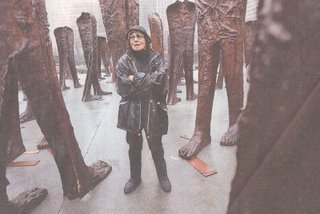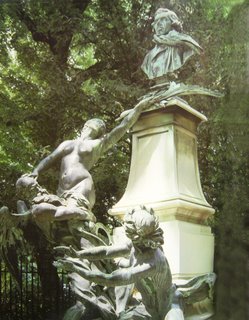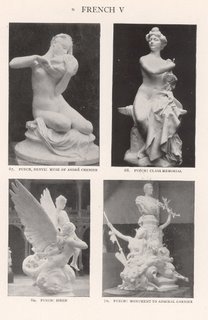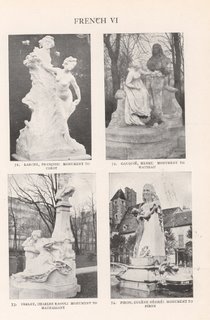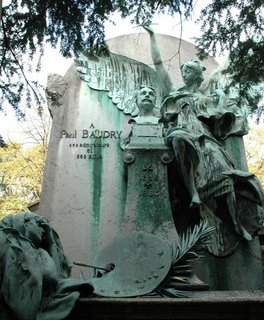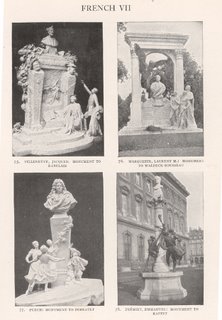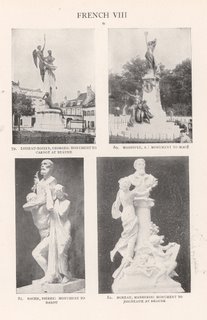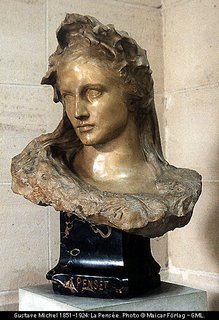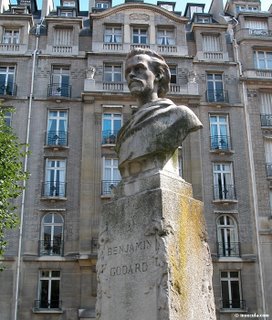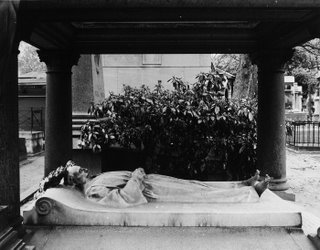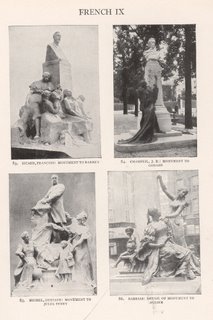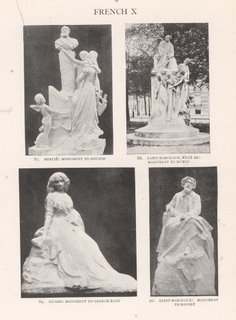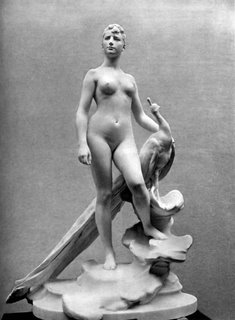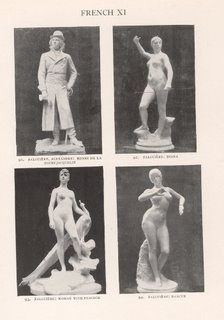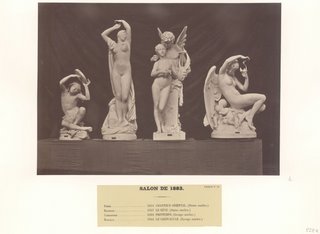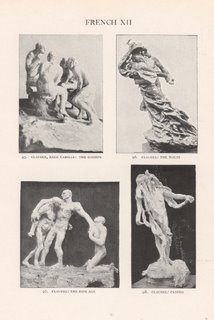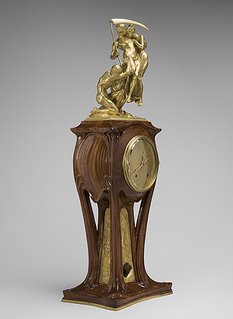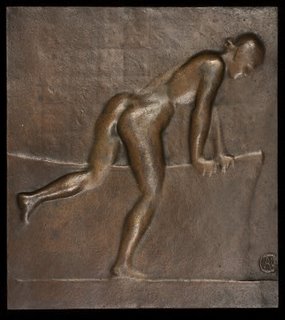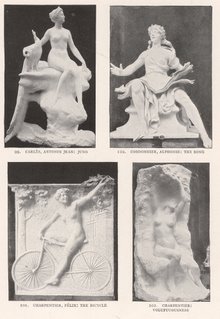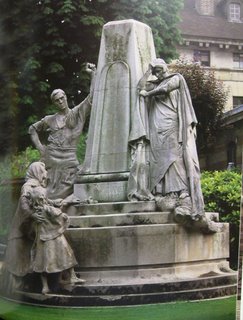Modern French Sculpture - part 3
 Maillol,"Night", 1902
Maillol,"Night", 1902Here are the concluding paragraphs about France taken from Lorado Taft's "Modern Tendencies In Sculpture" -- originally presented as the Scammon lectures of 1917. Mrs. Maria Sheldon Scammon endowed this lecture series that they might "be upon the history, theory, and practice of Fine Arts (graphic and plastic) by persons of distinction or authority .. primarily for the benefit of the students of the Art Institute" -- and perhaps that explains why Taft shows more enthusiasm in excoriating the work he dislikes instead of waxing elouquent on his favorites.(my comments -- as I think of them -- will be appearing in yellow - and contrary to daily nature of blogging -- I think I'll be adding more pictures and comments over time)
Readers are invited to post their responses to all of these comments and statues -- and if they seem to enhance this entry, I'll edit them into the text -- in green or various other colors.
............................................................................
Before speaking of such conspicuous insurgents as Maillol, Bourdelle, and the more reasonable Bouchard, I wish to emphasize the fact that there has always existed a group of sane,' sincere, and diligent craftsmen who, according to their varying tastes and intelligence have upheld the reputation of French sculpture.
One of the most ingenious and poetic of these men is Jean Dampt, whose little “Saint Jean”
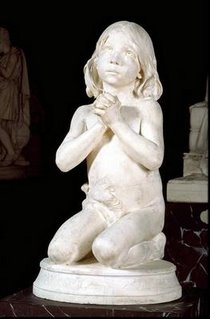 Saint Jean (1891)
Saint Jean (1891)and “l’Aleule”
 L'Aleule (1893)
L'Aleule (1893)have long adorned the Luxembourg. In the latter work he recognizes Rodin's great discovery of the contrasts possible in marble-cutting, yet shows no hint of exaggeration or sensationalism. Such virtues of reticence have always been the attributes of a considerable number; amid the annual riot of inanities one finds now and then a beautifully modeled figure like Dagonet's "Eve" (Fig. 106)
 Dagonet "Eve" (Salon of 1895)
Dagonet "Eve" (Salon of 1895)or Lefevre's "Happiness" (Fig. 105), works of most conscientious and !ntelligent execution. Another truly, sculptural utterance is Ernest Dubois' version of the prodigal's return, called "The Pardon" (Fig. 104).
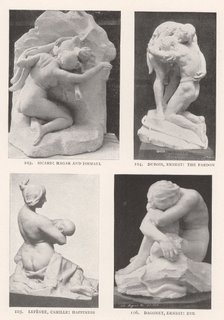 Figures 103-106
Figures 103-106"The Two Mourners" (Fig. 109) by Riviere is an appealing group which illustrates the present tendency of the sculptor to "keep the work white." The phrase is only another way of describing the subordination of non- essentials, the suppression of dark shadows, the emphasis of the mass. Obviously this is advantageous from several points of view; not least of these being the elimination of purely realistic and insignificant details, with consequent enhancement of essentials. In the hands of a beginner "full of enthusiasm and ignorance" the result may be like the "Child with a Balloon" (Fig. 111) by a young lady modeler, who has produced little else but "whiteness." Tisne's portrait-study, "Tout en Fleurs" (Fig. 110), shows not only grace but a charming tonality, while Vermare in his "Pierrot" (Fig. 108) has given us a real tour de force. You could tell that Pierrot was dressed in white by the very" feel" of the statue though you were in the dark!
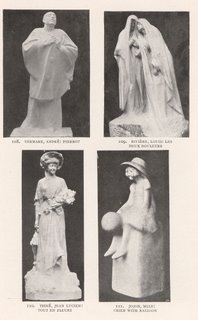 Figures 108-111
Figures 108-111It was Roger-Bloche who modeled "Le Froid" (Fig. 112), that unhappy pair whom you may have seen shivering on a hot summer day at the entrance of the Luxembourg. Some years ago this artist employed his unusual talents in "L'Accident" (Fig. 114), a circle of detached figures gathered around a workman apparently fallen at a street corner.. It was a bit of journalism of wonderful skill and characterization, but having no more sculptural intent than the most childish of our own John Rogers' early "groups." Probably it was but an experiment -- an adventure in panoramic art---for the sculptor gloriously redeemed himself the next year with a work of concentrated emotion called "The Child" (Fig. 113).
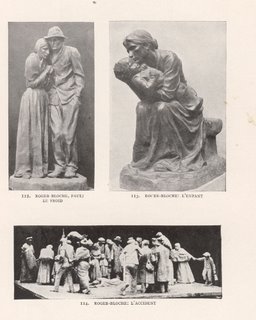 Figures 112-114
Figures 112-114Strange it is that gifted men should expend months of toil upon hopelessly unsculptural themes. Lefebre's relief, "Springtime" (Fig. 115), for instance, shows three young couples in realistic modern costume walking up the side of a great block of marble. These romantic pairs are separated by some space and evidently desire more; as a composition they have no relation to one another. "Aux Champs" (Fig. 116) by Guillaume represents a peasant with a wheelbarrow heaped high with hay. He is followed at a respectful distance by his faithful wife, and there is apparently no structural reason why the procession should not include a dozen children, dogs, and farm animals strolling in, all as casual as a baby's arrangement of its Noah's ark figures. "Grape-Gathering in Champagne" (Fig. 117) includes a considerable portion of the vineyard. Doubtless the composition would be even more scattered today! But why multiply illustrations? I have no desire to make this book a collection of warnings.
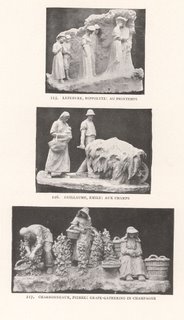 Figures 115-117
Figures 115-117Some of the genuinely able men who have recently compelled attention in Paris are not altogether to our provincial taste. The reaction against highly finished and realistic work has been so pronounced that primitive methods like those of Maillol afford sharp contrast to much already shown. For a time this gifted experimenter affected an absurd naivete, which from the well~trained hand of such an artist was like baby talk on the lips of an adult. Later works ring more true. I rather like his "Flora" (Fig. 121), although she has fallen upon pitiful, meager times. The elementary power of his well~known relief of two kneeling figures is instantly recognizable. The "Seated Woman" (Fig. 118) and the "Crouching Woman" (Fig. 120), likewise, have a massive majesty which is founded upon truth; they are not like Gaudier's inflated monsters. These are simply studies well begun which have been arrested in their development.
 Figures 118-121
Figures 118-121A sculptor of unusual vitality and of unlimited vogue is Emile Bourdelle. He would seem to be the direct successor of Rodin, whose portrait he has made to look like a Triton or Silenus (Fig. 122). Such works as the sketchy " Mother and Child" (Fig. 124), the masterful "Ingres" (Fig. 123), and the brooding "Beethoven" (Fig. 125)
 Figures 122-125
Figures 122-125are more attractive than his pet "Hercules" (Fig. 128), the charm of which I fail to appreciate. I find myself less cold toward the reliefs of the Theatre of the Champs Elysees (Figs. 126 and 127) which, it must be acknowledged, do play their part well upon the massive front of the building. What would Clodion and Bouchardon have said to such petrified rag time? Admirably harmonious with the architecture, they are of course quite justifiable, but some of us are so conservative that we prefer the rhythms of Jean Goujon or of the Greeks.
 Figures 126-129
Figures 126-129Another man of remarkable power is Paul Landowski. His primitive builder, known as "TheArchitect" (Fig. 129), is not the conception of a weakling; there is nothing lackadaisical nor anemic about such art as this! An even more original work by the same sculptor is called “The Sons of Cain" (Fig. 130). One of these figures is supposed to represent the primitive shepherd, another the ancient blacksmith with his treasured flame, and the third the original poet of the race. As devoid of complicated line as Rodin's "Burghers of Calais," it is nevertheless a virile work of unusual strength. The "Hymn to Aurora" at first glance is pure realism-two nude figures which look like casts from nature, standing side by side. There must be more there, however, for these primeval worshipers are unforgettable in their sincerity.
Greatest of this new generation, in my humble judgement, is that adventurous but well balanced genius, Henry Bouchard, who early commanded attention through his prize-winning model for the Reformers' Memorial. (Fig. 131), a work recently erected in Geneva. After the monuments of Paris, with which you have been regaled, you can imagine the sensation created by this austere design when it appeared some fifteen years ago. It is built into the ancient city walls and forms one of the most impressive of Europe's sculptural records.
 Figures 130-132
Figures 130-132A group of stalwart " Iron-Workers" had come earlier. They are superbly modeled and powerful in movement but there is a forced balance in the composition, an obviously studied symmetry, which smacks of the Beaux- Arts. From this the young master has since completely emancipated himself in a series of most original and varied works.
Here, for instance, is his memorial (Fig. 135) to four victims of an aeronautic accident of some years ago. No wealth of elaboration, no tangled allegory, could surpass the appeal of these silent sleepers.
This "Blacksmith in Repose" (Fig. 134) looks little enough like the traditional objet de Paris of our mantels. Its author is not concerned with the superficial graces, but what a satisfying expression of physical adequacy is found here! The bronze, somewhat larger than life, is a prized possession of the Metropolitan Museum of New York.
One of Bouchard's most original and most fascinating figures is his "Master Workman" (Fig. 133), carved in that same Paris limestone. He is supposed to be one of the many nameless masters of the craft who produced the miracles of Gothic art. I am mistaken; he has a name--Pierre de Montereau-and he built the Sainte Chapelle for good Saint Louis. In the delightfully sculptural garments of his day, with clumsy plumb-bob and level at hand, he sits upon a waiting block, his eager eye following the growth of climbing spire or buttress. The simplicity of the conception is refreshing; the result highly statuesque.
 Figures 133-136
Figures 133-136It is not strange that this figure should have led to another, an ideal portrait of an old-time sculptor. In this case who could have better claim to recognition than the sturdy Flemish-Burgundian, Claus Sluter (Fig. 137),
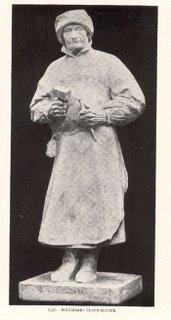 Figure 137
Figure 137he of the "Fountain of Moses" and the splendid monuments to Philip the Hardy at Dijon? No data exist; the portrait is quite fanciful, but it is certainly one of the most picturesque and vivid of all sculptured effigies.
I fear I shall not convince you of the beauty of Bouchard's "Fishermen" (Fig. 136).
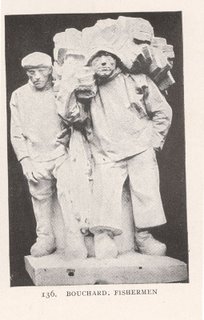 Figure 136
Figure 136The group is not beautiful according to any conventional rule; yet to me in its strong, solid mass it is one of the most interesting things upon my list. "
And then, when you have just decided that our hero has gone over entirely to the joys of characterization- that he has forever turned his back upon grace and charm -we find him doing something as astonishingly refined and classic as this fountain group, "Girl with a Gazelle" (Fig. 146).
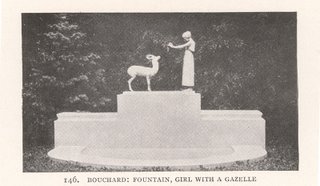 Figure 146
Figure 146It gave me such a surprise that at first I could not believe it from the same hand. I am so glad that he did it!
Francois Sicard unites with the traditional cleverness of the French sculptor a vigorous imagination. He has shown from year to year a succession of important works -serious, impressive things which justified the labor put upon them. And the labor has not been spared, for all are in marble and wonderfully wrought. One portrays "The Good Samaritan" bearing his helpless burden. Finer still is the "Hagar and Ishmael" (Fig. 103).
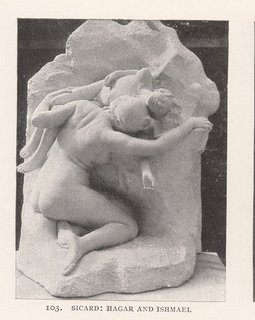 Figure 103
Figure 103The artist had received the Prix de Rome in 1891., and this dramatic group was his first envoi. The mother has laid her perishing boy upon a rocky ledge and while supporting him there hides her agonized face from his misery. The subtle modeling of the nude bodies is enhanced by the contrasting background of rugged rock. To a sculptor this range of treatment suggests the laborious evolution of soft flesh from the shapeless boulder-that unwilling genesis which Rodin has so often illustrated in the gamut of his great works. Here, however, we find no eccentricities, no exaggerations, no contortions; the group is simple and direct, full of feeling and masterly in its every touch. It won a first medal at the Salon, and one feels that, that year at least, the distinction must have been fitly bestowed.
At the Salon of 1905 Sicard received the medal of honor for his memorial to George Sand (Fig. 89), previously mentioned.
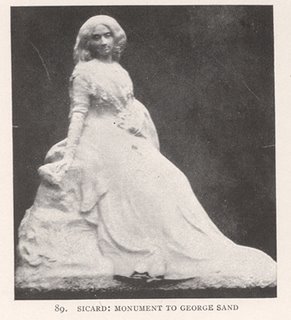 Figure 89
Figure 89This fine presentment of the writer offers with admirable precision the head and striking features of the subject carved in a large, simple way while the remainder of the figure is "thrown out of focus" as it were-subordinated with a nice sense of discrimination, yet without a suspicion of weakness in the drawing.
Another most satisfactory work of Sicard's which has also been referred to is his memorial to M. Barbey (Fig. 83), a philanthropist of Mazamet.
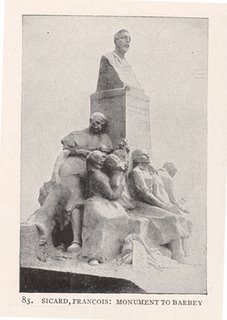 Figure 83
Figure 83Here he incorporated a number of appealing character studies and has skillfully avoided the ever-present danger of making the actors likewise spectators. These humble beneficiaries of the generous giver whom they honor are at their ease and most natural, yet the sculptor has made them a part of the monument. In many of the preceding examples there has been a suggestion of a breathless pose-a tableau that would fall apart as soon as an imagined curtain went down. Here, however, is no threat of such catastrophe; these figures have a structural and loyal part in the composition. I cannot say as much of the same artist's big panoramic group of the Pantheon. A recent trifling fancy, a "Scarf Dancer" (Fig. 142), by Sicard has so much charm, such Gothic naiveté, that it must be admitted to our record.
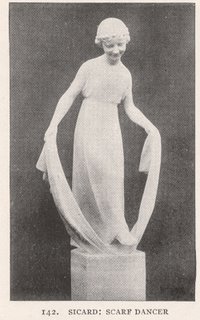 Figure 142
Figure 142Charles Despiau has a group of devotees, for whom his primitive heads are the acme of interpretation. To attempt to analyze their appeal would be to profane them. I shall therefore let "Paulette" (Fig 150) speak for herself. If she only could do so 1 am sure that one would hear her addressing "La Femme Inconnue" as "Tante" if not "Maman"!
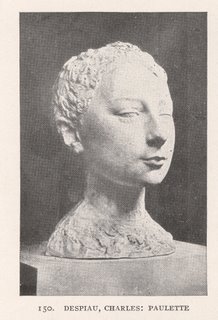 Figure 150
Figure 150Another discovery rewarding my search for the quaint and unusual is the work of Rene Quillivic. His interest in his home people is not wasted. Very well worth doing was his "Breton Embroiderer" and the delightful "Petite Bigoudaine" (Fig. 147),
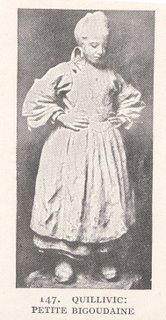
while his "Breton Mourners" (Fig. 140) are so completely in the spirit of their tragic corner of the earth that they might almost have stepped down from an ancient "calvaire" of Finistere. Is it one of their sailor dead whom they lament, these labor-worn, stiff-draped figures?
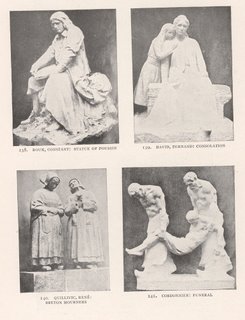 Figures 138-141
Figures 138-141Perhaps we have him here in this strange group by Cordonnier (Fig. 141). But no; these are foundrymen bearing the victim of an accident. What a striking and original composition it makes! Cordonnier is retrieving himself. Related in spirit is another work, "Consolation" (Fig. 139) by F. David;
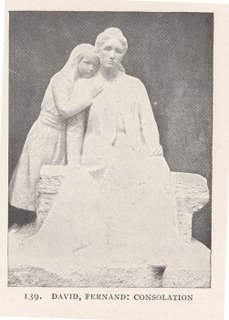
a group of truly sculptural intent combined with a gracious tenderness which has not been overdone and turned into sentimentality.
The same breadth of handling we find in "Le Soir" (Fig. 148) by Jacquot.
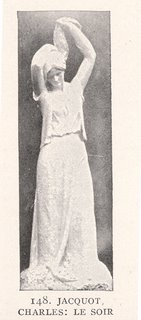 Figure 148
Figure 148This may be a tiny statuette, but it has the quality of work largely conceived. A real master of. his craft is Jules Desbois. His "Winter" (Fig. 144)
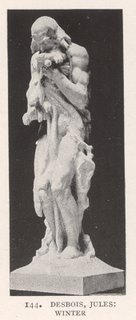 Figure 144
Figure 144is but one among a hundred beautiful and expressive figures bearing his name, while in "La Source"-another familiar theme-we have a beautiful composition and such richness of modeling, such complete ness of fulfilment, as must win the quick admiration of sculptors of every land.
A companion to Bouchard's "Master Builder" in the court of the Louvre is Roux's portrait of Poussin (Fig. 138),
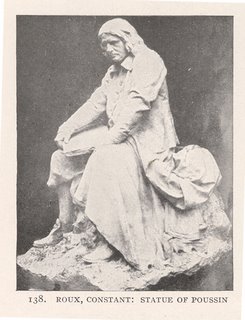 Figure 138
Figure 138an excellent characterization, large and simple in handling, as it must be for the limestone in which it is so ably carved.
Michel's monument to Beethoven (Fig. 145) in the Salon of fateful 1914 was very impressive.
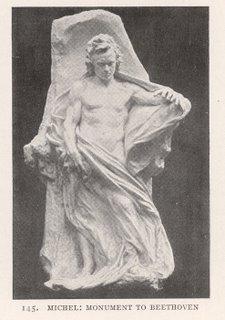 Figure 145
Figure 145Two other works of that year claim recognition. One is Monard's elegiac "Aux Aviateurs" (Fig. 149).
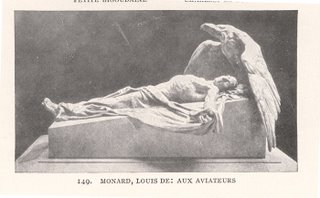 Figure 149
Figure 149How widely must those eagle wings spread today to protect the myriad dead who received their summons amid the clouds!
The other is this "Fra Angelico" (Fig. 143).
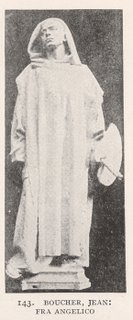 Figure 143
Figure 143I saw it first pictured in a foreign magazine, and later the original appeared with the French exhibit at San Francisco. I tried to get someone to buy it for the Art Institute-and it has found a resting-place in the Detroit Museum! It is only a small bronze, but to me this little effigy of a monk ~ a big work. The sculptor is. not Bouchard, but Jean Boucher, of whom I know nothing except that he made it. The figure has all of the dignity and reticence which a portrait statue should possess as its very first essential -- the quality so generally lacking in recent monuments in France. That it should be one of the latest expressions of French sculpture is an omen full of promise.
It was the writer's somewhat melancholy privilege to see the Salon of 1919. The exhibit was a brave attempt on the part of the artists, but its poverty revealed the fact that the "devastated area" was not all at the front. The victory which at so staggering a cost had finally come to a tormented land was not here celebrated by means of beautiful ideas worthily realized but through familiar conventional symbols. As wrote one of their critics: "The sculpture show is more like a barnyard than an art exhibition; the Gallic cock crows from every pedestal." The suggestions for military memorials were almost without exception banal; evidently the big men had not yet begun to collect their thoughts.
Nevertheless, even in that trying hour of exhaustion and lassitude, there were to be discovered occasional works of great value. Three busts of singular vividness and simplicity of treatment left pleasant memories and deserve mention.
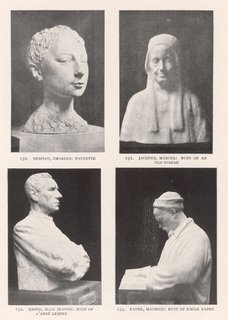 Figures 150-153
Figures 150-153One showed an old woman with closed eyes (Fig. 151), a portrait lovingly modeled and carved by Marcel Jacques. Another represented a man en- grossed in a book (Fig. 153), by Maurice Favre. The legitimate realism of the gray rock, the odd cap, and above all, the reader's look of concentration in the midst of so much vehemence-living and simulated- in which he was engulfed, made this work very conspicuous.
Most notable, however, was the bust of an abbe carved in porous stone (Fig. 152). Absolutely free from uncertainty, without a faltering stroke, this austere characterization stands ,out in memory as the dominant sculpture of the Salon of 1919. What was one's surprise to find it signed by a woman---Mille Jeanne Hanin. A nation showing craftsmanship like this and such virility in the work of its women will not rest long in eclipse. France will continue to lead the world in "the arts of space and time."
